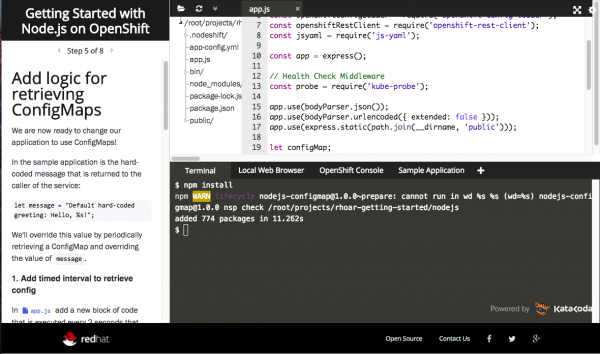Developing applications on a Kubernetes distribution like Red Hat OpenShift—or on Red Hat Enterprise Linux (RHEL), or by using our Universal Base Images—is easier with Red Hat's build of Node.js. The latest update of Red Hat Runtimes now includes Node.js 12.4.1, which provides a supported runtime for LTS releases. This new Red Hat build of Node.js together with the release of Red Hat Enterprise Linux 8.1 provides a number of new features and enhancements compared to Node.js 10.
This article focuses on these new features and enhancements.
New and changed features
With the latest RHEL 8.1 and the Red Hat Build of Node.js 12, we now provide a number of new features and enhancements over version 10. Notable changes include:
- Upgraded the V8 engine to version 7.4.
- Added a new default HTTP parser,
llhttp(no longer experimental). - Integrated the capability to generate heap dumps.
- Added support for ECMAScript 2015 (ES6) modules.
- Improved support for native modules.
- Removed the requirement for worker threads to have a flag.
- Added a new experimental diagnostic report feature.
- Improved performance.
For detailed changes in Node.js 12.14.1, see the upstream release notes and upstream documentation.
Deploying the new build on OpenShift
Nodeshift is an opinionated command-line application and programmable API that simplifies the deployment of NodeJS apps to OpenShift. To help with this process, Red Hat creates and maintains Source-to-Image(S2I) container images for Node.js. The blog Use Node.js 12 on Red Hat OpenShift today explains how to deploy your Node.js projects to OpenShift using Nodeshift.
Documentation
The Runtimes team continuously adds to and improves the official documentation for Red Hat’s Node.js build. This work includes updates in the Release Notes and the Node.js Runtime Guide.
Developer interactive learning scenarios
These self-paced scenarios, such as Figure 1, provide you with a pre-configured OpenShift instance that is accessible from your browser without any downloads or configuration. Use this tool to experiment with Node.js or learn about other technologies within Runtimes, and see how Node.js on OpenShift helps solve real-world problems.

Conclusion
Our goal has always been to provide rapid releases of the upstream Node.js core project. Doing this allows us to provide, for example, applications and tools to get developers up and running quickly, Node.js container images, and integrations with other components of Red Hat’s cloud-native stack. If you need it, Red Hat provides both production and development support for supported configurations with Red Hat OpenShift, Red Hat Enterprise Linux, and Universal Base Images.
More resources
Check out the following resources:
- Article: Develop with Node.js in a container on RHEL
- Background: Red Hat joins the Node.js Foundation
- Downloads: Container images for the Red Hat build of Node.js
- How-to: Protect Your Node.js REST Clients with Circuit Breakers
- Node.js 12: Use Node.js 12 on Red Hat OpenShift today
- Presentation: Node.js on OpenShift for Your Enterprise
- Product page: Red Hat's Node.js build
